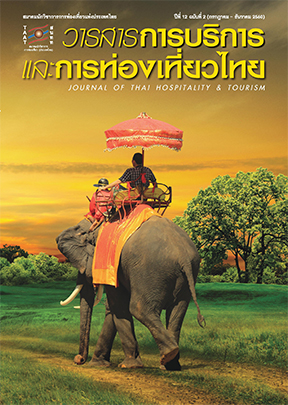โครงสร้างองค์ประกอบความพึงพอใจของนักท่องเที่ยวต่างชาติต่อคุณภาพบริการ สปาในประเทศไทย
Main Article Content
บทคัดย่อ
บทความนี้มีวัตถุประสงค์ เพื่อจำแนกผลกระทบที่แตกต่างของแต่ละคุณภาพบริการสปาที่มีต่อความพึงพอใจรวมของผู้ใช้บริการสปาไทย โดยประยุกต์ใช้วิธี Penalty-Reward และแนวคิดโครงสร้างองค์ประกอบสามด้านของความพึงพอใจของผู้บริโภค วิเคราะห์ข้อมูลที่ได้จากสัมภาษณ์นักท่องเที่ยวต่างชาติที่ใช้บริการเดย์สปาและโฮเต็ลแอนด์รีสอร์ทสปา ผลการศึกษา พบว่า คุณภาพบริการแต่ละด้านของเดย์สปาและโฮเต็ลแอนด์รีสอร์ทสปาจัดอยู่ในกลุ่มโครงสร้างองค์ประกอบสามด้านของความพึงพอใจที่แตกต่างกัน อย่างไรก็ตาม ความสะอาดและการให้ความสนใจต่อคำตำหนิ/ปัญหาที่เกิดขึ้นกับผู้ใช้บริการเป็นเงื่อนไขสำคัญที่ต้องมีสำหรับธุรกิจสปา ส่วนทักษะการนวดเป็นปัจจัยที่ธุรกิจสปาใช้แข่งขัน สำหรับสภาพแวดล้อมและบรรยากาศเป็นปัจจัยที่ส่งเสริมความได้เปรียบในการแข่งขันของธุรกิจสปา การศึกษาเสนอว่า ผู้ประกอบควรให้ความสำคัญกับความสะอาดและสนใจต่อการตำหนิของผู้ใช้บริการในลำดับแรก ส่วนการควบคุมคุณภาพบริการของเทอราปิสต์ และการลงทุนปรับปรุงสภาพแวดล้อมและบรรยากาศเป็นสิ่งที่จะช่วยเสริมสร้างความสามารถในการแข่งขัน นอกจากนี้ภาครัฐควรมีนโยบายส่งเสริมการพัฒนาทักษะการให้บริการของเทอราปิสต์ สิ่งเหล่านี้จะช่วยยกระดับความสามารถในการแข่งขันของธุรกิจสปาในประเทศไทย
Article Details
เอกสารอ้างอิง
[2] Alegre, J., & Garau, J. (2011). The Factor Structure of Tourist Satisfaction at Sun and Sand Destination. Journal of Travel Research, 50(1), 78-86.
[3] Bartikowski, B., & Llosa, S. (2004). Customer Satisfaction Measurement: Comparing Four Methods of Attribute Categorisations. Service Industries Journal, 24(4), 67-82.
[4] Brandt, R. D. (1987). A Procedure for Identifying Value-enhancing Service Components Using Customer Satisfaction Survey Data. In C. Suprenant (ed.). Add Value to Your Service (pp.61-65). Chicago: American Marketing Association.
[5] Busacca, B., & Padula, G. (2005). Understanding the Relationship between Attribute Performance and Overall Satisfaction. Market Intelligence and Planning, 23(6), 543-561.
[6] Chi, C. G. Q. & Qu, H. (2008). Examining the Structural Relationships of Destination Image, Tourist Satisfaction and Destination Loyalty: An Integrated Approach. Tourism Management, 29(4), 624-636.
[7] Deng, W. (2007). Using A Revised Importance-Performance Analysis Approach: The Case of The Taiwanese Hot Spring Tourism. Tourism Management, 28(5), 1274-1284.
[8] Department of International Trade Promotion. (2015). Market Value of Thai Spa Industries. Bangkok: Department of International Trade Promotion.
[9] Euromonitor International. (2012). Health and Wellness Tourism in Thailand. Euromonitor International.
[10] Fuchs, M., & Weiermair, K. (2003). New Perspectives of Satisfaction Research in Tourism Destination. Tourism Review, 58(3), 6-14.
[11] Fuchs. M., & Weiermair, K. (2004). Destination Benchmarking: An Indicator-System Potential for Exploring Guest Satisfaction. Journal of Travel Research, 42(3), 212-225.
[12] Füller, J., & Matzler, K. (2007). Customer Delight and Market Segmentation: An Application of the Three-Factor Theory of Customer Satisfaction on Life Style Groups. Tourism Management, 29(1), 116-126.
[13] Füller, J., Matzler, K., & Faullant, R. (2006). Asymmetric Effects in Customer Satisfaction. Annals of Tourism Research, 33(4), 1159-1163.
[14] Jain, S. K., & Gupta, G. (2014). Measuring Service Quality: SERVQUAL vs. SERVPERF Scales. VIKALPA, 29(2), 25-37.
[15] Juga, J., Juntunen, J., & Grant, D. B. (2010). Service Quality and its Relation to Satisfaction and Loyalty in Logistics Outsourcing Relationships, Managing Service Quality, 20(6), 496-510.
[16] Kaosa-ard, Mingsarn et al. (2010). Integrated Development of Sustainable Tourism in the Mekong Region Phase IV. Chiang Mai: Social Research Institute, Chiang Mai University.
[17] Kozak, M. (2004). Destination Benchmarking: Concepts, Practices and Operations. Wallingford, UK: CAB International.
[18] Matzler, K., & Sauerwein, E. (2002). The Factor Structure of Customer Satisfaction: An Empirical Test of the Importance Grid and the Penalty-Reward Contrast Analysis. International Journal of Service Industry Management, 13(4), 314-332.
[19] Untong, Akarapong. (2015). Image, Motivation and Experience of International Tourists Using Thai Spa. Research Methodology & Cognitive Science, 12(2), 13-22.
[20] Untong, Akarapong., & Kaosa-ard, Mingsarn. (2014). Spas Performances Benchmarking and Operation Efficiency. Applied Economics Journal, 21(1), 1-19.
[21] Untong, Akarapong et al. (2014). Competitiveness of Thailand’s Health Tourism Industry (Spa). Chiang Mai: Public Policy Study Institute.
[22] Vavra, T. G. (1997). Improving Your Measurement of Customer Satisfaction: A Guide to Creating, Conducting, Analyzing, and Reporting Customer Satisfaction Measurement Programs. Milwaukee, WI: ASQ Quality Press.
[23] Vildova, E., Martincik, D., Tluchor, J., & Jakubikova, D. (2015). Measuring Customer Satisfaction and Loyalty in Spa Companies. Marketing & Trade, 1, XVIII, 151-168.
[24] White, H. (1980). A Heteroscedasticity-Consistent Covariance Matrix Estimator and A Direct Test for Heteroscedasticity. Econometrica, 48(4), 817-838.
[25] Yilmaz, Y., & Bititci, U. (2006). Performance Measurement in the Value Chain: Manufacturing V. Tourism. International Journal of Productivity and Performance Management, 55(5), 371-389.
[26] Zhang, X., Song, H., & Huang, G. Q. (2009). Tourism Supply Chain Management: A New Research Agenda. Tourism Management, 30(3), 345-358.


